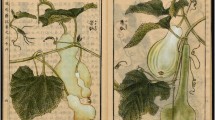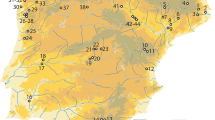Abstract
Cultivation of plants in northern China began at an early date. A number of domesticates were derived from native species, and others were introduced from southeastern Asia. Many vegetable species are included in myths and stories of ancient China. These traditional stories, as well as ancient agricultural and medicinal books, often mention cultivated members of the Cucurbitaceae. Twelve genera and 18 species of cucurbits are currently under cultivation in China. A number of them appear to be endemic to Indochina, while others were introduced from Western Asia and the New World. A recent trip to China and a survey of Chinese literature indicated that many cucurbits are consumed in the immature state as vegetables, some are eaten as fruits, and various species are used for medicine and a variety of other purposes.
Zusammenfassung
Resumen histórico de las plantas domésticas de la China con énfasis en las Cucurbitaceae. El cultivo de las plantas comenzó en una edad temprana en el norte de China. Varias plantas domésticas fueron derivadas de especies nativas, mientras que otras fueran introducidas desde el sudeste de Asia. Las historias y los mitos de la China antiqua cuentan de diversas especies vegetales. Estos relatos tradicionales, tanto como los viejos libros de las agricultura y medicina, frecuentemente mencionan los miembros cultivados de las Cucurbitaceae. Hoy en día se cultivan doce géneros y dieciocho especies de las familia en la China. Algunas Cucurbitaceae parecen ser endémicos de la Indochina, mientras que otras fueron introducidas desde el oeste de Asia y del Nuevo Mundo. Un viaje reciente a la China y un estudio de la literatura China indicaron que muchas Cucurbitaceae son consumidas en el estado inmaduro, algunas son comidas como frutas, y varias especies son utilizadas en medicina otros propósitos.
Similar content being viewed by others
Literature Cited
Aldwinckle, H. S., M. Iizuka, and D. H. VanSloten. 1986. Temperate fruit crop germplasm in China. FAO PI. Genet. Resources 68:35–41.
Ames, O. 1939. Economic annuals and human cultures. Bot. Mus. Harvard University, Cambridge.
Anderson, E. N., and M. L. Anderson. 1977. Modern China: south. Pages 319–357in K. C. Chang, ed., Food in Chinese culture: anthropological and historical perspectives. Yale Univ. Press, New Haven, CT.
Blasdale, W. C. 1899. A description of some Chinese vegetable food materials. USDA Exp. Sta. Bull. 68.
Burkill, J. H. 1935. A dictionary of the economic products of the Malay Peninsula. Crown Agents for the Colonies, London.
Chang, K. C. 1968. The archaeology of ancient China. 2nd ed. Yale Univ. Press, New Haven, CT.
—. 1970. The beginnings of agriculture in the Far East. Amer. Antiquity 35:175–184.
—. 1977. Ancient China. Pages 25–52in K. C. Chang, ed., Food in Chinese culture: anthropological and historical perspectives. Yale Univ. Press, New Haven, CT.
Chen, C. S. 1970. The agricultural regions of China. Pages 2–17in M. Y. Nuttonson, ed., The agricultural regions of China. Amer. Inst. of Crop Ecol., Silver Spring, MD.
Christie, A. 1968. Chinese mythology. Hamlyn Publishing Group Limited, London.
Crook, F. W., and L. A. Bernstein. 1974. Agriculture in the United States and the People’s Republic of China, 1967–71. USDA Foreign Agric. Econ. Rep. 94.
Dahlen, M., and K. Phillipps. 1983. A popular guide to Chinese vegetables. Crown Publ., New York.
Decker-Walters, D. S., and T. W. Walters. 1988. 1987 germplasm collections of cultivated cucurbits from China and Hong Kong. Cucurbit Genet. Coop. Rep. 11:93–94.
Degener, O. 1947. Flora Hawaiiensis. Book 5. Privately published, Honolulu.
Girardot, N. J. 1983. Myth and meaning in early Taoism. Univ. California Press, Berkeley.
Gorman, C. F. 1969. Hoabinhian: a pebble-tool complex with early plant associations in southeast Asia. Science 163:671–673.
—. 1977. A priori models and Thai prehistory: a reconsideration of the beginnings of agriculture in southeastern Asia. Pages 321–355in C. A. Reed, ed., Origins of agriculture. Mouton Publ., Paris.
Harlan, J. R. 1975. Crops and man. American Society of Agronomy; Crop Science Society of America, Madison, WI.
Hedrick, U. P. 1972. Sturtevant’s edible plants of the world. Dover Publications, Inc., New York. Reprint of a work first published, asSturtevant’s notes on edible plants, by J. B. Lyon Co., Albany, in 1919.
Heiser, C. B., {jrJr.} 1973. Variation in the bottle gourd. Pages 121–128in B. J. Meggers, E. S. Ayensu, and W. D. Duckworth, eds., Tropical forest ecosystems in Africa and South America: a comparative review. Smithsonian Inst. Press, Washington, DC.
—. 1979. The gourd book. Univ. Oklahoma Press, Norman.
—. 1980. The species ofLuffa. The Gourd 10:6–7.
Herklots, G. A. C. 1972. Vegetables in south-east Asia. George Allen and Unwin, London.
Ho, P. T. 1955. The introduction of American food plants into China. Amer. Anthropol. 57:191–201.
—. 1969. The loess and the origin of Chinese agriculture. Amer. Hist. Rev. 75:1–36.
—. 1975. The cradle of the east. Univ. Chicago Press, Chicago.
—. 1977. The indigenous origins of Chinese agriculture. Pages 413–484in C. A. Reed, ed., Origins of agriculture. Mouton Publ., Paris.
Jeffrey, C. 1979. A new combination inThladiantha (Cucurbitaceae) for a Chinese medicinal plant. Kew Bull. 33:393–394.
—. 1980. The Cucurbitaceae of eastern Asia. Royal Botanic Gardens, Kew, England.
Keng, H. 1974. Economic plants of ancient north China as mentioned in Shih Ching (Book of Poetry). Econ. Bot. 28:391–410.
Kitamura, S. 1951. The origin of the cultivated plants of China. Acta Phytotax. Geobot. 14:81–86.
Li, H. L. 1969. The vegetables of ancient China. Econ. Bot. 23:253–260.
—. 1970. The origin of cultivated plants in southeast Asia. Econ. Bot. 24:3–19.
Li, S. C. 1973. Chinese medicinal herbs. Georgetown Press, San Francisco.
Linnaeus, C. 1753. Species plantarum. Impensis Laurentii Salvii, Holmiae.
Mallick, M. F. R., and M. Masui. 1986. Origin, distribution and taxonomy of melons. Sci. Hort. 28:251–261.
Menninger, E. A. 1977. Edible nuts of the world. Horticultural Books, Stuart, FL.
Merrill, E. D. 1935. A commentary on Loureiro’s “Flora Cochinchinensis.” Trans. Amer. Philos. Soc. 24:376–381.
Morton, J. F. 1967. The balsam-pear: an edible, medicinal and toxic plant. Econ. Bot. 21:57–68.
—. 1971. The wax gourd, a year round Florida vegetable with unusual keeping quality. Proc. Florida State Hort. Soc. 84:104–109.
Mote, F. W. 1977. Yuan and Ming. Pages 193–258in K. C. Chang, ed., Food in Chinese culture: anthropological and historical perspectives. Yale Univ. Press, New Haven, CT.
National Academy of Sciences. 1975. Plant studies in the People’s Republic of China. National Academy of Sciences, Washington, DC.
National Geographic Society. 1982. Journey into China. National Geographic Society, Washington, DC.
Nelson, E. C. 1986. Notes on economic botany of China: Augustine Henry 1893. Boethius Press, Kilkenny, Ireland.
Nuttonson, M. Y. 1963. The physical environment and agriculture of central and south China, Hong Kong, and Taiwan (Formosa). Amer. Inst. of Crop Ecol., Silver Spring, MD.
Organisation for Economic Co-operation and Development. 1985. Agriculture in China: prospects for production and trade. Organisation for Economic Co-operation and Development, Paris.
Organ, J. 1963. Gourds. Faber and Faber, London.
Porterfield, W. M., {jrJr.} 1943. Luffas as they are used by the Chinese. J. New York Bot. Gard. 44: 134–138.
—. 1951. The principal Chinese vegetable foods and food plants of Chinatown markets. Econ. Bot. 5:3–37.
Purseglove, J. W. 1968. Tropical crops. Dicotyledons 1. John Wiley and Sons, New York.
Reed, C. A. 1977. Origins of agriculture: discussion and some conclusions. Pages 901–953in C. A. Reed, ed., Origins of agriculture. Mouton Publ., Paris.
Samson, J. A. 1980. Tropical fruits. Longman Group Limited, New York.
Sands, W. N. 1928. The bitter-cucumber of Paris. Malayan Agric. J. 16:32–39.
Schafer, E. H. 1967. Ancient China. Time-Life Books, New York.
—. 1977. T’ang. Pages 85–140in K. C. Chang, ed., Food in Chinese culture: anthropological and historical perspectives. Yale Univ. Press, New Haven, CT.
Shen, T. H. 1984. Agricultural resources of China. Cornell Univ. Press, Ithaca, NY.
Shih, S. H. 1962. A preliminary survey of the book Ch’i Min Yao Shu: an agricultural encyclopedia of the 6th century. Science Press, Beijing.
Spence, J. 1977. Ch’ing. Pages 259–294in K. C. Chang, ed., Food in Chinese culture: anthropological and historical perspectives. Yale Univ. Press, New Haven, CT.
Sprague, G. F. 1975. Agriculture in China. Science 188:549–555.
Stover, L. E., and T. K. Stover. 1976. China: an anthropological perspective. Goodyear Publ. Co., Pacific Palisades, CA.
Tregear, T. R. 1980. China: a geographical survey. John Wiley and Sons, New York.
Walters, T. W., and D. S. Decker-Walters. 1988. Balsam-pear(Momordicachamntia,Cucurbitaceae). Econ. Bot. 42:286–288.
Watson, W. 1969. Early cereal cultivation in China. Pages 397–402in P. J. Ucko and G. W. Dimbleby, eds., The domestication and exploitation of plants and animals. Gerald Duckworth and Co., London.
Whitaker, T. W., and G. N. Davis. 1962. Cucurbits: botany, cultivation, and utilization. Interscience Publ., Inc., New York.
Whitton, C. L. 1984. Agricultural statistics of the People’s Republic of China, 1949–1982. USDA Statist. Bull. 714.
Yu, Y. S. 1977. Han. Pages 53–84in K. C. Chang, ed., Food in Chinese culture: anthropological and historical perspectives. Yale Univ. Press, New Haven, CT.
Yuan, C. K. 1985. Index florae Yunnanensis. The People’s Publishing House, Yunnan.
Zee, S. Y., and L. H. Hui. 1981. Hong Kong food plants. Urban Council, Hong Kong.
Zeven, A. C, and J. M. J. deWet. 1982. Dictionary of cultivated plants and their regions of diversity. Centre for Agricultural Publishing and Documentation, Wageningen, Netherlands.
Author information
Authors and Affiliations
Rights and permissions
About this article
Cite this article
Walters, T.W. Historical overview on domesticated plants in China with special emphasis on the Cucurbitaceae. Econ Bot 43, 297–313 (1989). https://doi.org/10.1007/BF02858729
Received:
Accepted:
Issue Date:
DOI: https://doi.org/10.1007/BF02858729




